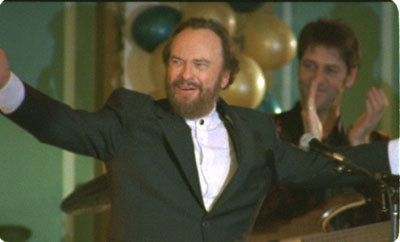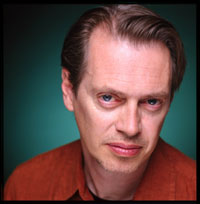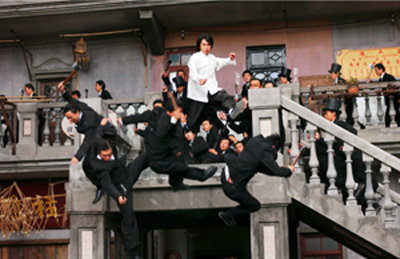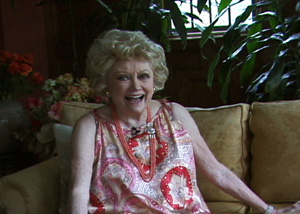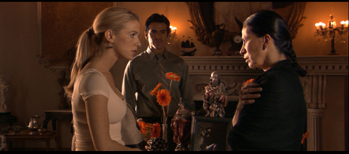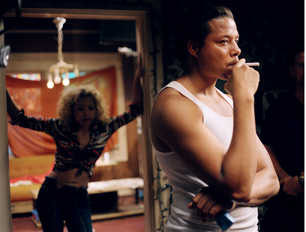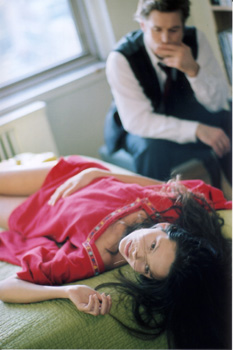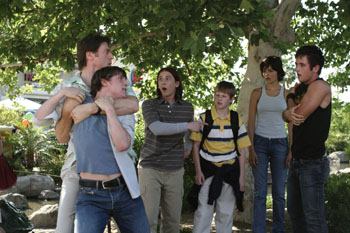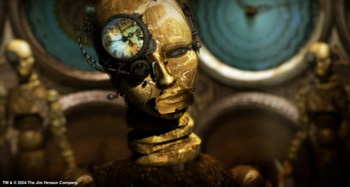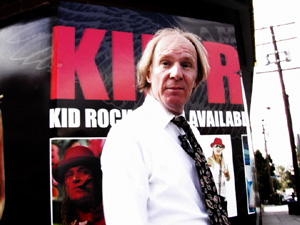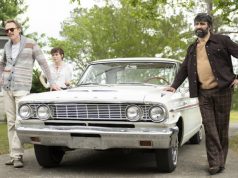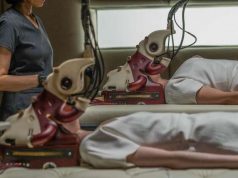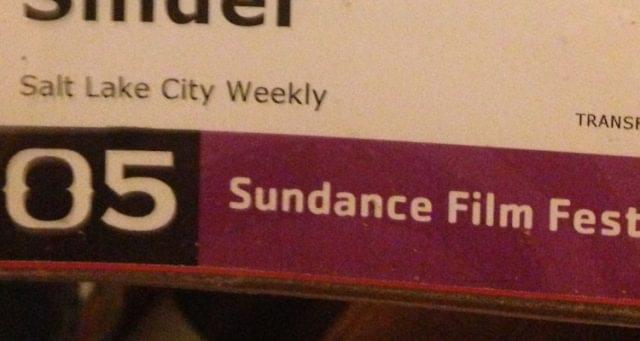
Day 1 (Thursday, Jan. 20, 2005):
The first day of Sundance is always a Thursday, and the only event is the opening-night film in Park City, which is preceded by a welcome address from festival founder and timid woodland creature Robert Redford. As a rule, I do not attend this event, because why drive to Park City just to watch ONE movie? Redford is cool and all, but I wouldn’t go to all that trouble just to see him speak for a few minutes. Clint Eastwood, yes, and certainly Steven Spielberg. But Redford? Nah.
Day 2 (Friday, Jan. 21, 2005):
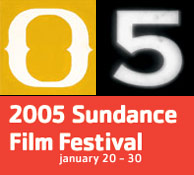
My reputation is as a person who plans to attend 9 a.m. screenings yet fails to actually do so, but today was different. I awoke at 6:45 a.m., showered, dressed and made the 35-minute drive to Park City, checked in at festival headquarters, and was in my seat at 8:40. Eight-forty, my friends! And more to the point, 6:45, my friends! I had forgotten what 6:45 looked like, at least coming at it from that direction. (I’ve seen it as I was GOING to bed a number of times, of course.)
It feels good to get up early and get a head-start on the day, though as with most things that are good for me, I decline to do it regularly. Today felt especially good because the fantastic weather we’ve been having the past few days continued: clear blue skies and temperatures in the low 40s. The low 40s sound cold, but when it is often overcast and in the 20s, you are grateful for sunny and 40. It’s nature’s way of tricking us into being appreciative of crappy things.
A couple years ago, a third press-screening venue was added at one of the Holiday Village Cinemas theaters — an actual movie theater, as opposed to a hotel ballroom with ad-hoc seating. That venue only hosted one or two screenings a day, but still, it was nice to have.
This year, further advances have been made. That Holiday Village theater has been upgraded to full service, with six screenings a day, just like the other two venues. That makes a total of 134 press screening slots — enough for every film in the festival to be shown once, and another dozen or so shown twice.
In addition, one of the press-screening venues has moved. It used to be downstairs from the Eccles Theatre, which is the festival’s main venue. The press-screening room was small and often too hot, though it was convenient for when you attended a public screening at the Eccles and wanted to just dash downstairs afterward for a press screening.
Now that small Eccles press venue has closed and in its place there is a second venue at the Yarrow Hotel. So two press-screening venues are in the same hotel, mere feet from each other — and the third venue, at the Holiday Village Cinemas, is just across the parking lot. For denizens of press screenings, this means no shuttle-busing back and forth, and no reason to even go outside, really, which is a boon to film geeks, since our skin is pasty and sensitive to the elements.
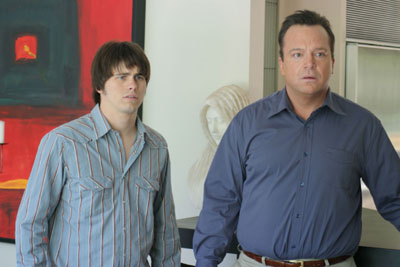
Anyway, my first screening — the one at 9 a.m.! that I made it to on time! — was in the new Yarrow venue, and I found it to be large and spacious and as uncomfortable as its older Yarrow brother. But still. The movie was the one that was shown at the big opening-night gala last night, “Happy Endings,” from the man who gave us “The Opposite of Sex.” It’s a fairly funny movie (with Lisa Kudrow, Jesse Bradford, Jason Ritter and others), but at 128 minutes, it’s long. Most Sundance films clock in at around 90 minutes, and most comedies in general aren’t much longer than 100. A hundred and twenty-eight, that’s Oscar drama length, there, and “Happy Endings” is not an Oscar drama.
Next up, in the other Yarrow room, was “9 Songs,” from director Michael Winterbottom. I rather enjoyed Winterbottom’s Sundance entry from a few years ago, “Wonderland,” though I have found much of his other work to be as cold as his name. (Seriously, “Michael”? *shudder*) “9 Songs” is, um, pornography. Usually I don’t stumble onto the pornography until much later in the festival, but here I was, porning it up before noon on the first day.
Technically it’s just a movie about this couple who go to a lot of concerts and who, when they are not at concerts, have sex a lot. But I know porn when I see it, and trust me, this was porn. Not very good porn, either, not that I’m a conoisseur. It was only 69 minutes long, though (tee-hee!), so that’s a plus. But really, when you’re being bored and titillated simultaneously, time moves very slowly.
I had a few minutes after “9 Songs,” so I walked over to Burger King, the official sponsor of Eric’s diet when he’s at Sundance. Then it was back to the Yarrow (which sounds like a pirate hotel if you say it right: “Yarrrrrr-ow”). While in line to see “The Jacket,” starring Adrian Brody and his amazing colossal nose, I met up with my pals from HollywoodB****Slap.com, Erik, Scott and Chris (“The Movieman,” “The Angry Jew” and “Oz,” respectively). I was happy to see them all in good health in spirits since our last in-person visit together, one year ago. They flew in from Chicago, Philadelphia and Vancouver this morning, and boy were their potty mouths tired! Like sailors they swear, all of them. But I love the little effers!
“The Jacket,” which already has a distributor (Warner Independent) and a movie trailer, was a hot ticket for us press types, who like to be able to tell people when a movie comes out in the summer that we saw it way back in January. Inexplicably, it was being shown in the smaller of the two Yarrow venues, so many press people were turned away.
This caused a bit of pre-screening drama when Anthony Kaufman, film critic for the Village Voice, returned from the bathroom to find that Ruthe Stein, film writer for the San Francisco Chronicle, had taken his jacket from the chair on which he had placed it and had begun to occupy the chair. She had stolen his seat, in other words. He had clearly marked it as his by putting his coat on it, and she had simply moved the coat and taken the seat. And now there were no seats left. And Ruthe Stein would NOT relinquish her ill-gotten seat.
Kaufman left the room and returned three times, each time trying to reason with the woman, but she would not budge. I heard him say one time that if he did not see this movie, he would lose his job, which probably was an exaggeration. But I suppose people who are attempting to retrieve their property from madwomen are entitled to a bit of hyperbole.
Eventually, he became quite vocal and caused a scene — which was exactly the right tack to take, as it made Ruthe Stein’s craziness a matter of public record and, in theory, embarrassed her. “Who ARE you?!” he demanded several times, not in the way of, “What is your name?” or “Who do you think you are?,” but more like, “Who DOES that? Who steals someone’s chair and then refuses to give it up?” The crowd was on his side and applauded him. Ruthe Stein would not move.
Eventually, the man sitting next to Ruthe Stein, perhaps seeking to avoid any further ugliness, gave up his seat and left the room. This meant Kaufman had a seat, but it was a seat next to his nemesis, Ruthe Stein. We found this delightful. We hoped maybe they would fall in love during the film.
But alas, “The Jacket” was not the sort of movie that inspires love. (Ironically, it was a jacket that caused the trouble in the first place.) The title character of “The Jacket” is a straitjacket, specifically one that gets put on Adrian Brody when he’s in a nuthouse, and when he’s wearing it, he can travel through time. Um, sort of. It’s a lot like “Butterfly Effect,” but without Ashton Kutcher, which I’m sure you’ll agree is a good thing.
Mere moments after “The Jacket,” I watched “Loggerheads.” This is an ensemble drama taking place in North Carolina on three different Mother’s Days. Bonnie Hunt is in it, and man, I love her. I’d go to Park City just to watch her introduce a movie, too.
“Loggerheads” got out at around 6:30 p.m., which meant I had seen four movies in just over nine hours. My previous record for single-day viewing was four movies, so I only had to see one more to break that. I had time to see two more, but six movies in one day, that’s crazy talk. Besides, I needed to take a break to write and to wander around Main Street and look for famous people.
So I took the shuttle bus up to Main Street. On the bus, I heard a man and woman discussing the recent influx of Asian directors, particularly directors of horror films. The man said, “I was just getting used to all those Mexican directors we had to know, and now there’s all these Korean and Japanese ones.” This is the sort of problem that independent-film lovers have.
Main Street was a-bustle with activity, it being the first real night of the festival and a Friday to boot. There is only one Sundance screening venue on Main Street, the classy old Egyptian Theatre, but it’s full of shops and restaurants and party venues, thus making it THE place to be if you are a celebrity, although mostly it is populated by people who are merely looking for celebrities. The actual celebrities are hiding.
But I did see Jay Mohr, host of the Sundance Channel’s daily updates, being prepped and primped in Sundance’s makeshift studios in what I think is usually an art gallery. I also saw two women having their picture taken with a man who looked familiar, so I asked them who he was. They said he was on “Queer as Folk” and his name is Robert Gant. I looked it up on the Internet Movie Database and was able to verify this. Why he looked familiar to me, I don’t know, since I’ve never watched that show. I think he just looks a lot like Ryan on “The O.C.,” and hence familiar to me (even though I am so over “The O.C.” now).
After I had dawdled long enough, I found a quiet place and wrote for a while, including some of the very words you are reading now. Then it was back down to the Yarrow to kill some more time before my 10 p.m. screening of “Oldboy.”
“Oldboy” is a Korean film from one of the aforementioned Asian directors that we have to get used to nowadays. His name is either Park Chan-wook or Chan-wook Park; I know the Asian method of naming is opposite from ours, but I can never tell when it’s the original Korean version and when it’s been Westernized. Anyway, that’s his name, and “Oldboy” is a freaky movie about a guy who gets locked in a room for 15 years then gets out and wants revenge on whoever locked him in there. At one point he extracts a man’s teeth with a hammer, rendering him incomprehensible, so that his dialogue has to be subtitled … in Korean, originally, which means his subtitles have to be subtitled, too. The movie is JUST THAT FREAKY.
Before the film, the publicist handed out a notice that reads (and I quote exactly):
NON-DISCLOSURE AGREEMENT: By entering these premises and viewing “Oldboy” you agree to hold in confidence all information regarding the end of said Film and further shall not directly or indirectly disclose to others such information.
In other words, don’t spoil the ending. I’m not sure which specific plot points they were referring to, though, because the movie ends for about 20 minutes. You keep thinking it’s over, and then it’s not done and you have to let it be over some more. So I just won’t tell you anything else about the movie, except that at the very end the main character dies in a fiery explosion.
The screening ended just after midnight. Who scheduled the 119-minute movie as the last screening of the day? Somebody evil, that’s who.
And that did it for me. Five movies in one day. I headed home, still thinking about Ruthe Stein of the San Francisco Chronicle. If she should happen to read this and want to give her side of the story, I’d be glad to print it, though I reserve the right to make fun of it, too.
Day 3 (Saturday, Jan. 22, 2005):
Remember how I got up at 6:45 a.m. yesterday? What was up with THAT?
Today I got up at 9:45, which is much more reasonable (though still early, since I didn’t get to bed until 3 a.m.). Even still, I barely made the 11:30 film, due to the shuttle-bus system having changed since last year. See, they added a new public-screening venue, at the Park City Racquet Club, which means the shuttle buses have to, you know, stop there. This meant changing the whole route, and the result is that while the Yarrow used to be quite easy to get to from festival headquarters, now it’s the last stop on the route. In fact, there are two different routes, and it’s the last stop on both of them.
I happened to see Oz from HBS.com, and we traveled together. We arrived at the theater at 11:40, 10 minutes late for “Forty Shades of Blue.” Luckily, the movie started nine minutes late, so we had only missed, like, half a shade.
The movie is a slow drama starring Rip Torn that I found engrossing at first but less so as it went on. Oz had the opposite reaction; he said it grew on him. But I should point out that Oz is Australian, so he thinks it’s summer right now, too.
Since the movie started nine minutes late, that meant it ended nine minutes late, too. Hence, instead of having 13 minutes to make it to the next screening, I had four. Luckily, the next screening was just over at the Holiday Village, a one-minute walk — three minutes to spare, but I do like to use the restroom first, you know?
Anyway, Erik and Scott from HBS.com were there, saving me a seat. It was between them, unfortunately, so I had to endure Scott’s asking me every five minutes what time it is. (“Time to buy a watch,” I told him. Ha ha! I’ve got his number!) The movie was “The Matador,” starring Pierce Brosnan as an alcoholic hitman who is slowly losing his mojo. Greg Kinnear plays the regular Joe who befriends him in Mexico City. It’s quite a funny movie, with Brosnan giving one of his most enjoyable performances to date, full of vulgar figures of speech. (“I look like a Bangkok hooker on a Sunday morning after the Navy leaves” is one of the more printable ones.)
Halfway through the movie, the words “Press Any Button” appeared on the screen superimposed over the movie, and began moving around, like a computer that’s gone to screensaver. Evidently some digital-projection-type thing up in the booth had gone to sleep. If you’re curious what it looks like to see “Press Any Button” on Pierce Brosnan’s face, don’t worry, David Poland of Movie City News took a picture.
I had a few hours before the next screening, so I vowed to get some writing done. This plan was thwarted, however, by my Salt Lake City friends Michael and Jamie, who have no business at Sundance, yet who were calling to tell me they were here. Seeking, as always, any excuse not to work, I took the bus up to Main Street to meet them for a few minutes.
On the bus I chatted with a California-based contributor to a Chicago newspaper who mentioned Santa Monica three times in two minutes.
I found Michael and Jamie. They had already seen Jesse Bradford (of “Bring It On” and “Swimfan,” and of “Happy Endings” at this year’s fest) and had taken a picture of him, despite not knowing who he was, only that he appeared to be famous. I guess maybe someone was in the act of kissing his butt or something. Anyway, they showed me the picture, and I ID’ed him.
They had also seen noted hobbit Elijah Wood dining with friends at an outdoor cafe, so we returned to the scene so I could gawk. Elijah was bundled up in large sunglasses and a scarf, obviously trying to avoid detection, which seems like it would defeat the whole PURPOSE of Sundance, but whatever. I mean, if you don’t want people to recognize you, don’t get famous, all right? Anyway, seeing that other people were harassing him for photos (during which he was very gracious, I should mention), we opted not to add to his misery. So we merely whispered and giggled for a few minutes about how tiny he is in real life — I suspect they actually had to make him look bigger in order for him to play a hobbit — and then left.
I subsequently had this phone conversation with my friend Rob:
ME: I saw Elijah Wood.
ROB: I feel like I should know that name….
ME: Did you see any of the “Lord of the Rings” movies?
ROB: No.
ME: (pause) Why are we even friends?
The HBS.com crowd are staying in a house on Park Avenue, in the midst of the Sundance hubbub. I have no idea how they got it; they have outstanding accommodations every year, possibly via illegal means. In fact, I assume it’s via illegal means. This year they are sharing their house with actresses Joan Chen and Elizabeth Peña. I don’t know how that happened, either. I don’t really understand anything about my HBS.com friends, now that I think about it.
Anyway, I stopped by their house for a few minutes to write and chit-chat, and then Erik and I headed back to the Yarrow for a couple more screenings. We could have taken a shuttle bus, but traffic was so bad we suspected we’d make it there faster if we walked. We were right. It’s a 15-minute walk from their house to the Yarrow, and the bus was still behind us when we arrived. This is why public transportation does not work and should be abandoned.
The movie was “Lonesome Jim,” a “Garden State”-ish dark comedy about a sadsack who goes home to Indiana to have a nervous breakdown. Steve Buscemi directed it but does not appear in it, THANK GOODNESS. (That man is UGLY.) We found the film quite enjoyable, though I think it often sacrifices realism for the sake of a joke. But then, don’t we all?
We had a brief break, and then it was back into the screening room for “Pretty Persuasion.” This is a dark comedy a la “Heathers” or “Mean Girls” about high school girls who accuse their teacher of sexual assault. Scott joined us for this film, and afterward we were split. Scott loved it, saying it was a scathing, angry indictment of modern America; I took the opposite view, that Scott is a moron. No, kidding. I thought the first half of the movie was very funny but often too obviously trying to be “outrageous,” and that the second half of the film was considerably less funny and eventually ugly and heavy-handed. Erik was somewhere between us. We discussed it in a lively fashion as we walked back to the HBS house, where we discovered Elizabeth Peña. (The alleged Joan Chen was nowhere to be found. Perhaps she discovered she was going to be bunking with three Internet film critics and Elizabeth Peña and got a hotel.)
Elizabeth is an extremely friendly and lovely woman. She is famous, but not the kind of famous that makes me recognize her. (I did spot her voice, though: She was Mirage in “The Incredibles.”) I see she’s been in films like “Rush Hour” and “Tortilla Soup,” but eh; still not ringing any bells for me. Anyway, she’s very nice. I hope I get a chance to see her Sundance movie, “How the Garcia Girls Spent Their Summer.”
Oz, Erik, Scott and I then departed for Main Street, where Oz had finagled an invitation to a party at a restaurant/bar, hosted by Femme Fatale. I had never heard of it, but apparently Femme Fatale is one of those Maxim-type men’s magazines with pictures of half-naked women and articles about cars and sex. The party was too full to permit any additional guests without violating fire codes, but Oz knows a guy. Specifically, he knows a guy named Paul from Femme Fatale magazine. Paul led us to the door, where he shmoozed like a pro with the gatekeepers. One of them said, “We’re totally to capacity,” and Paul replied, “Oh, but have you talked to Jamie?” And he dropped a couple other names, too. Evidently this carried some weight, this Jamie person and her associates, because we were allowed into the party.
The party was crammed with fresh-scrubbed pretty people, the sort of people who would either, depending on their gender, appear in or subscribe to Femme Fatale magazine. Erik and I noticed that there was a table with free food on it, so we made a beeline. Unfortunately, a young couple, he in tattered jeans and a trendy tight T-shirt, she in a furry white jacket, were posted in front of the table, filling their plates and taking a good long while to do so. Perhaps they were removing all the carbs manually. I craned my neck to see around them to the table itself and found nothing terribly appetizing anyway, mostly just that froofy party food, like little things on little crackers. But I did see a big bowl of tortilla chips, so I reached over and grabbed some.
Erik said, “Ten dollars if you take the bowl with you and walk around the room with it.” I had been planning on doing this anyway, so Erik’s dare was unnecessary. The bowl wasn’t doing anyone any good on the table, where Trendy Couple were blocking it; if I carried it around the room, it could benefit all in attendance.
So I became Chip Boy. Party-goers were surprised to see a man toting a bowl of chips around with him, but they were grateful to have the localized service. It became a conversation piece, a way to mingle and chat with strangers, and also to maintain my status as someone who is a dork with no dignity. I only regretted that I could not carry salsa with me, as I needed a free hand to hold my beverage.
Day 4 (Sunday, Jan. 23, 2005):
There is a film playing at the festival called “The Aristocrats,” a documentary in which a few dozen famous comedians tell the same filthy joke, each putting his own spin and personality on it. This joke has been around since the vaudeville days, passed from one comedian to another, and told mostly just in private comedian gatherings like Friars Club dinners and country club events, seldom in public.
Being a fan both of comedy and of secret things — all of the press materials regarding this film don’t even hint at what the joke actually is, only saying that it’s the filthiest thing you’ve ever heard — I am curious to see it, and I was looking forward to the press screening at noon today. Unfortunately, yesterday they revised the schedule and moved “The Aristocrats” to 8:30 a.m. If you have been reading these diary entries regularly, I’m sure I don’t need to explain why that is a problem.
Nonetheless, I set my alarm for 6:45 this morning, and I stumbled out of bed when it went off. I immediately discerned that I was in no condition to do anything other than get back in bed, and that even that task would require superhuman effort. I was unable to speak or even think in English. Only two of my senses were working, and neither of them was sight or hearing. I had had less than four hours of sleep, and no amount of caffeine was going to repair that. I resolved to scrounge a ticket to the public screening set for Tuesday afternoon instead.
So my first movie of the day was “The Dying Gaul” at 11:30 a.m., and I found it extremely compelling. It features performances from Campbell Scott, Patricia Clarkson and Peter Sarsgaard that are probably the best of all three of those actors’ careers. It is about a gay writer (Sarsagaard) who writes a screenplay based on the recent AIDS death of his boyfriend. Scott plays the Hollywood executive who will pay him $1 million for the script — but only if he changes the dying boyfriend character to a woman, to make the film more palatable to straight America. Oh, and then the executive and the writer become lovers, even though the executive has a wife; whoops!
After this film I headed to festival headquarters to put in a request for a ticket to “The Aristocrats” on Tuesday, and to pick up my ticket for today’s public screening of “Kung Fu Hustle” at the Eccles Theatre. This was my first public screening of the festival, and I was looking forward to it. I don’t like regular mulitplex audiences, what with the talking and the eating and the coming in late and the answering cellphones, but Sundance audiences are different. I suspect waiting in the cold for two hours to get into the film makes them determined to concentrate on it no matter what. And it’s fun to be at a premiere with the director and cast members, and to see an audience’s reaction to a new work.
Before the film started, I happened to see Roger Ebert, the dean of modern American film criticism, in the crowd. I think he has become easily entertained in his old age — the number of 3-star reviews he gives astonishes me — and he makes a lot of little factual errors nowadays, but let’s face it: The guy can write. Good heavens, can he write. He’s not as erudite as the Entertainment Weekly critics, nor as urbane as the New York Times crowd. But in terms of sheer sentence-assembling and brisk readability, he cannot be beat.
I introduced myself to him two years ago at the festival, back when he was still the world’s fattest man, weighing well over 1,200 pounds. Then he missed last year’s fest due to health problems, so it was good to see him back again now. I don’t watch his TV show, so I haven’t seen him lately, and I was surprised to see how, well, old he looks. I mean, he looks well — color in his face, spry and lively as always in his conversation — but he looked well for an old man. He’ll be 63 this year, and I don’t want him to be that old, and I don’t want him to have health problems, because being that old and having health problems tend to cause people to die. And as much as I want his job, I don’t want him to have to die for me to get it. (Actually, if his death DID mean I would get his job, like automatically, I would probably revise that position. But in realistic terms, where I will never, ever have his job, I am firm: I don’t want Roger Ebert dead.)
I reintroduced myself to him and said I was a fan of his work as a fellow film critic, and he asked me who I write for. I told him I’d done some pre-festival stuff for Salt Lake City Weekly and that I also write for HollywoodB****Slap.com. (I find it awkward to tell people, “My name is Eric D. Snider and I write for EricDSnider.com.”) He said, “Oh, that’s a good site.” I was a little surprised he was familiar with HBS.com, so I said, “Really?” And he said, “Well, it’s readable.” But he said it like a compliment, as in, “Well, a lot of stuff on the Internet isn’t even readable, but not HBS.com!”
I had not planned any further conversation with him than “hello,” but now he engaged me in further discussion. “Have you seen ‘Murderball’?” he asked as he sat down in the aisle seat. I squatted next to him and said, “No, but I hear it’s very good.” (It’s a documentary about quadriplegic men who play rugby in their wheelchairs.) He confirmed that it is, and I said I hoped to see it.
Seeing it now was my turn in the Sundance volley of casual conversation to bring up a film, I said, “Have you seen ‘Inside Deep Throat’?” It is a documentary about the adult film “Deep Throat” that became a cultural touchstone in the early ’70s, and the reason I mentioned it to him was that I had just heard some people on the shuttle bus talking about how fantastic it was. He said he had not seen it, but that there was a press screening tonight at 10 p.m. that he was considering attending. But he wanted to know: Should he see some other film that was playing at 8:30, or should he see “Inside Deep Throat” at 10? Roger Ebert wanted my advice on what movie to see! Unfortunately, not having seen either of the films in question (I forget what the other one was), I could only rely on hearsay, which was in favor of the porn documentary. So that was the advice I gave him. I returned to my seat, pleased to have had a friendly conversation with one of my professional role models, and fearful my recommendation would turn out to be a bad one and that he would hate me for it and put in his will that even after his death, I am not to have his job.
“Kung Fu Hustle” is a film by Chinese director Stephen Chow, one of about a dozen people I can think of who are always described as “huge stars in Asia but little-known here in the states.” Apparently, Asia is brimming with fantastic talent that no one in America cares about. Chow writes, directs and acts in his films; his most recent one was “Shaolin Soccer,” which had a little cult following here in the U.S. (Actually, “cult following” was the best it could do, since Miramax never played it on more than about two screens at once, and never opened it at all in most of the country.)
“Kung Fu Hustle” is my favorite film of the festival so far. It’s a sheer joy to watch, an endlessly inventive and funny martial-arts film about a little slum being harassed by a gang of ax-wielding thugs. It seems to be set in the ’30s, and sometimes the thugs (who are dressed in black suits and tall top hats) break into dance, and sometimes the characters can run super-fast like the Roadrunner. It’s a wonderful movie. The audience gave Chow, who was in attendance, a thunderous ovation afterward. I noticed a quartet of geeks wearing T-shirts that said “Disciples of Chow,” with pictures from his movies on the back. It occurred to me that these men will have to be content with their love for Stephen Chow, as they will almost surely never know the love of a woman.
I had a couple hours to kill after “Kung Fu Hustle,” so I headed up to Main Street to hang out at the Sundance House, an art gallery that becomes a lounge and Internet cafe for passholders during the festival. As it happens, I arrived just in time for the opening reception for members of the press and for any filmmakers who care to show up. Seeing that there was free food and drink to be had, I entered.
While at the bar obtaining a Coke, I was approached by a friendly man who asked if I had a film at the festival. I told him I was but a lowly movie critic and asked if he had a film there. He said he did: “Shake Hands with the Devil.” Now, I watched a screener tape of this a couple weeks ago, and it is a very fine film, a documentary about the 1994 genocide in Rwanda, the same event as the recent film “Hotel Rwanda,” except a documentary. It turns out I was speaking with Peter Raymont, the director of the “Shake Hands with the Devil,” so I told him I liked his film very much, and he thanked me. He was enjoying the free martinis, and I feel I should emphasize the plural nature of the word “martinis.” He had two just during our conversation, and he showed signs of having had some before we met.
He observed that the Nick Nolte character in “Hotel Rwanda” was based loosely on Romeo Dallaire, the Canadian man who is the focus of his documentary. He said Nolte was all wrong for the part, and that the filmmakers didn’t even consult Dallaire before making their movie. I gently pointed out that Nolte’s character is a composite, based on Dallaire and someone else, but this did not stop Peter Raymont from being mildly annoyed by the whole thing. Nonetheless, he said, anything that causes people to think about the tragedy that occurred in Rwanda is a good thing. And it’s true: I myself have not killed a single Rwandan since watching these films.
Elsewhere at the party was enormous magician/comedian Penn Gillette, who, with fellow comedian Paul Provenza, made the aforementioned dirty-joke documentary “The Aristocrats.” I told them about the obscene starting time of the press screening and said I hoped to see it on Tuesday, as I’d heard many good things about it. They agreed with me that 8:30 is too early.
I then noticed a table that had a fountain of chocolate surrounded by a host of things to be dipped into it, fondue-style. I made a beeline, as dipping junk food into other junk food is, in my opinion, the very pinnacle of an unhealthy lifestyle. However, I soon discovered that my access to the table was blocked by Crispin Glover.
Yes, the man who played George McFly and who once nearly kicked David Letterman in the head on his own show was having fondue and chatting with some other festival-goers, and being an obstacle as he did so. Glover wrote and directed a movie called “What Is It?” that I plan to see later in the week and that I assume is crazy, just like he is. Seeing me approach, he introduced himself and immediately handed me a card with the screenings dates and times for “What Is It?,” then asked if I wanted to participate in a round-table interview with him on Friday. He said we could go find his publicist, who was somewhere at the party, and she could give me the details. I wasn’t really interested in doing any interviews, but I was very interested in getting him away from the fondue, so I let him lead me to his publicist, who agreed with me, once he had left us alone together, that he is crazy. (“Esoteric genius” is actually what she said, but she meant crazy.)
After I stuffed myself with fondue, I left the party and went to the lounge part of the Sundance House to write for a while. Then it was back down to the Holiday Village Cinemas for back-to-back documentaries: “Why We Fight” and the aforementioned “Inside Deep Throat.” (Both films include interviews with Gore Vidal, by the way. Evidently he is the go-to guy if you are interested in hearing about America’s love for war and/or fornication.)
“Why We Fight” is essentially “Fahrenheit 9/11” with Michael Moore removed (which, yes, makes it several hundred pounds lighter). It purports to be about why America has gone into battle in general in the past 50 years, but it’s really about why American went to Iraq. (Answer: No good reason.) The film is very sobering, but I wonder if we sort of already did this last year, with Moore’s film. Did we need another one?
“Inside Deep Throat,” which Roger Ebert did in fact attend, is a pretty entertaining examination of “Deep Throat” and what it did to American society and culture in the 1970s. The film is not itself pornography; it is merely ABOUT pornography. (I got my porn fix already, with “9 Songs.”) I don’t think the filmmakers make their case very strongly, though. They seem to assume that we already agree with them that adult films should not be banned or censored or prosecuted for violating decency laws. At the end, an onscreen title points out that the same laws used to prosecute the makers of “Deep Throat” are STILL ON THE BOOKS! And we’re supposed to be appalled that such archaic laws are still around, but I wasn’t appalled, because the film hadn’t done a good enough job convincing me that I needed to be. It assumed it was preaching to the choir, I guess, and didn’t realize that some non-members might wander in.
With four more movies under my belt, bringing my festival total (including 10 pre-festival screenings) to 23, it was time to retire for the night. On the shuttle bus back to the parking lot that contained my car, I found an unopened, perfectly good package of peanut butter and crackers — a satisfying conclusion to a satisfying day.
Day 5 (Monday, Jan. 24, 2005:
Today I saw many celebrities urinating. But we’ll get to that later.
My first film of the day wasn’t until noon, so I went to Sundance headquarters first to kill a few minutes and to see what free stuff there was. I found beverages, but since this is Sundance, it was only bottled water and froofy tree-hugger fake sodas. I tried one with the Wild Oats brand on it that was allegedly cherry vanilla but which was made without artificial flavors or colors and which, unsurprisingly, tasted like water that had been vaguely tainted with cherry and vanilla.
The noon movie was “Tony Takitani,” a somber 75-minute Japanese drama about a man struggling with loneliness. It is told almost entirely by a narrator, with very little spoken dialogue, apparently keeping in the spirit of the short story upon which it is based. The narration gives it a mythical, fabulous (as in, pertaining to fables) quality, and it’s an unusually lovely film. (Alas, I was so caught up in it that I failed to take notes adequate enough to write a review some two months later.)
After this I went to the Eccles Theatre for a public screening of “Marilyn Hotchkiss Ballroom Dancing & Charm School,” to commence as soon as they could get all the letters up on the marquee, or 3 p.m., whichever. While in the bathroom at the Eccles, whom should I see at the urinal but James Cromwell. He was the farmer in “Babe,” of course, and most recently he was seen on “Six Feet Under” as a crazy old man. When he was done peeing, I said, “That’ll do, James. That’ll do.” OK, I didn’t, but man, what if I DID?!
In the audience for the film were Ted Danson and his wife Mary Steenburgen, who appears in the film. Neither of them was peeing, at least not that I could tell.
“Marilyn Hotchkiss Etc.” turned out to be a rather dismal affair, competent but rough, and consisting mostly of dialogue that bears no resemblance to the way people actually talk. It’s about a widower who finds a new lease on life by taking ballroom dance classes, which he starts doing only because a dying John Goodman tells him to. You know how it is.
From there I scurried over to the Yarrow for a press screening of “Thumbsucker.” I got to sit with my Salt Lake City film critic buddies Jeff Vice (the Deseret Morning News) and Scott Renshaw (Salt Lake City Weekly). Scott is a regular fixture at Sundance press screenings, but we hardly ever see Jeff because he has a magic special press pass that gets him into all public screenings without having to show up early or wait in line. His crap, as they say, don’t stink.
Before the movie, I used the restroom and whom should I see at the urinal but famed magician Penn Gillette (of Penn & Teller). When he was done peeing, he showed me the secrets of how he did it. OK, he didn’t, but man, what if he DID?!
“Thumbsucker” is reminiscent of “Tadpole,” “Igby Goes Down” and many other quirky, sophisticated coming-of-age comedies. It’s about a 17-year-old boy who sucks his thumb when he’s stressed, and his attempts to overcome the habit. But it’s more about him, his mother and his father, and their various internal conflicts with themselves. It’s a very funny movie, and sweet, too, much like the two films I just compared it to. I suppose that’s why I compared it to them.
It was about 7:30 now. I had decided to catch the 11:30 p.m. public screening of “Strangers with Candy,” a feature film based on the Comedy Central series, and so I had a few hours to kill. I went to Main Street with the intention of hanging out at the Sundance House or the Starbucks/Media Lounge, or some such place. Main Street is loaded with spots like that, written up cheerfully in the Sundance film guide as being places where you can “drop by to check your e-mail, meet up with friends, catch a morning yoga class, or just warm up between screenings.” (That’s an actual quote.) What they don’t mention is that none of these venues have any compunction about closing randomly for private events. So sure, drop by to chill out for a while — as long as it’s not one of the 1,100 times during the week that the place has closed early so that Blender magazine can funnel liquor down Thora Birch’s throat.
As you might have guessed, all the places I wanted to sit and relax at were closed. I wandered up and down the street for a few minutes, but nothing much was happening. I suppose everyone was indoors, at those public venues that were closed now. But also, Main Street always slows down a bit after the first weekend of the festival, and probably more so this year, since the Oscar nominations are being announced tomorrow and a lot of the celebrities have fled back to L.A. for the occasion.
So I went to the house where the HBS guys and Elizabeth Peña are staying. Elizabeth was not to be found, but joining us was fellow HBS writer Carina (aka Maegs), up from Provo with her sister to watch a few screener tapes and live the Sundance life vicariously. We all chatted and made merry and watched a Slamdance film called “Abel Raising Cain,” about a media prankster. I’m not counting it, though, because mostly I typed on my laptop instead of watching it.
Now, I never saw more than a few minutes of “Strangers with Candy,” though I do find the stars — Amy Sedaris and Stephen Colbert — extremely amusing. But apparently the 30-episode series has a sizable cult following, because people were sitting in the wait-list line for tickets to the 11:30 showing as early as 6 p.m. (For a typical screening, people might show up two hours early at the most.) One guy told me he’s driven out from Detroit primarily just to see the film. (He was third in line for wait-list tickets, and about 50 of those people got in, so I assume he was one of them.) Earlier in the day, I saw a girl on the shuttle bus with a sign attached to herself saying, “Need ‘Strangers with Candy’ tickets. Will pay any price.” Her male companion’s sign read, “Need ‘Strangers with Candy.’ Am very open-minded.” I don’t like to contemplate what he was offering in exchange for tickets, but I hope he got them.
My point is, this was apparently a BIG DEAL. I got a press ticket (nyah nyah) and got a good seat early. The cast of the film was on hand, including Amy Sedaris, who I absolutely adore. She was behaving the way you’d expect her to, i.e., wacky. I do believe her brother, David Sedaris (one of my favorite writers), was in attendance as well, though I am not 100 percent certain it was him.
The crowd was obviously packed with big fans of the series, because they applauded pretty much everything that occurred in the film, often covering up the dialogue in doing so. You’d think after they missed a few lines they would realize maybe they shouldn’t clap for EVERYTHING — or maybe not even for ANYTHING, since IT’S A MOVIE, you idiots, not a concert — but in fact they did not.
Nonetheless, the movie “Strangers with Candy” is very funny for the first 45 minutes, just a wonderfully absurd comedy, and then it mellows out considerably. It commits to a particular plot line early on, and then has to see it through, and it gets bogged down in that. You can almost hear the movie saying, “Oh, geez, we introduced this story, didn’t we? Crap, now we gotta finish it.”
And thus the festival was half-over, and I was more than half-exhausted. I drove home half-asleep.
Day 6 (Tuesday, Jan. 25, 2005):
The main reason I saw “Strangers with Candy” last night was that the press screening for it was at 8:30 this morning, and you know how I feel about 8:30 a.m. screenings. Plus, it conflicted with the 9 a.m. press screening of “The Squid and the Whale,” which I had high hopes for. (Its writer and director is Noah Baumbach, who co-wrote “The Life Aquatic with Steve Zissou.”) Seeing “Strangers with Candy” last night freed me up to see “The Squid and the Whale” this morning.
In theory, anyway. In practice, again not getting to bed until 3 a.m., the possibility of getting up at 7 and making it to a 9 a.m. screening was remote. And indeed, the 9 a.m. screening and I continued not to be on a friendly basis. However, there is a public screening of “The Squid and the Whale” on Friday. However, it is at 9:15 a.m. Maybe this is on purpose. You know how some movies are only funny if you watch them really late at night? Maybe “The Squid and the Whale” is only funny in the morning.
Anyway, I rolled into Park City at about 10 and went to headquarters to see about the ticket I had requested for the public screening of “The Aristocrats,” a movie that is apparently SO offensive that someone who had never seen it posted a note on my Web site’s message board warning people not to. This only made me more curious, of course, which may have been the guy’s intention in the first place. Maybe he’s a publicist.
Imagine my dismay, then, when I was told by the very helpful Bert in the press office that he could not get a ticket for me. He expressed what seemed to be genuine regret over the state of things, but he only had two press tickets available, and he had to give them to the people who had asked before me (or, possibly, who were more important than me. You accept such matters of hierarchy at Sundance). He said another press screening would probably be scheduled for tomorrow, which is all well and good, except that now my afternoon for today was all screwed up.
I considered going to the theater and simply getting in the wait-list line with the common folk. I would have to stand in line, but if I did get a ticket, it would be free with my press pass. But getting a ticket seemed unlikely; this film was a hot commodity.
Then I remembered my buddy, whose name happens to be Buddy, who is a manager at the Sundance box office and who had said he might be able to hook me up if I ever needed him to. I called, he checked, and sure enough, he was able to finagle a ticket for me. I had to pay $8 for it, but still. As Paris Hilton will tell you, a hookup is a hookup.
In the meantime, I was scheduled to have lunch with Elyssa, an old co-worker of mine from a daily newspaper I used to work for that is now owned and operated by Satan’s minions from the fiery maw of hell. But Elyssa’s cool. We ate Mexican food at a restaurant that is not on Main Street, which means we didn’t have to wait for a table, and the food cost less than $1,000.
Then I headed to the Prospector Theatre to wait for “The Aristocrats.” It turned out to be a fascinating, often hysterically funny look at the inner workings of comedy. There is an old joke called “The Aristocrats” whose middle section allows the teller to improvise and come up with the filthiest, most taboo acts imaginable. The more shocking they are, the funnier the punchline eventually is. Because of the room for improvisation, comedians like telling it in private gatherings or amongst each other. Comics like to put their own signature on it, the way a singer will make a song “hers.” George Carlin’s version has lots of poop in it; Bob Saget (one of the filthiest comedians alive — I’m not kidding, either) includes a lot of sex in his. You get the idea.
The film has many clips of various comedians telling the joke, but mostly it’s comedians talking about HOW to tell the joke — what makes it funny, how it works, and so forth. This leads to a discussion of how comedy in general works, and why things are funny. It’s extremely insightful, in my opinion, and the best comedians don’t just throw a bunch of naughty words into it; they get descriptive and creative, and that’s where the humor comes in.
The film’s directors, Penn Gillette and Paul Provenza, were on hand afterward to take questions. Penn said he doesn’t want anyone to see the movie who wouldn’t enjoy it. He said, “Mel Gibson and Michael Moore — who are really the same person — they think their movies are so important, and everyone HAS to see them, and they’ll save the world.” But for “The Aristocrats,” Penn doesn’t want anyone wandering in who doesn’t have a significant interest in the dynamics of comedy, or who doesn’t like to see movies with dirty words.
I went back to headquarters after this to write and recuperate and such. They have a room with little tables set up, sort of like a coffee shop, but without all the hippies. While I was typing away on my laptop, a trio of Japanese people arrived and began occupying the other chairs at my table. It was one man and two women, and the man was clearly the leader, and he instructed the caucasian Sundance volunteer who was guiding them around to get them something. He spoke in Japanese, which the volunteer evidently understood, and the volunteer went off in search of whatever the item was.
Turns out it was coffee, and he brought back three cups of it. Or maybe he doesn’t actually understand Japanese, and coffee is just what he THOUGHT they wanted. At any rate, the leader instructed the volunteer to sit down and join them, which he did, at which point the three Japanese people began to talk very excitedly amongst themselves for a few minutes, whereupon they ran out of conversation and began quietly reading magazines. The volunteer continued to sit there, as instructed, not doing anything, apparently having been given as a gift to the Japanese people. I continued to type on my laptop and pretended not to notice that three Asians and their man-slave were sharing a table with me.
After a brief visit to the HBS.com/Elizabeth Peña house, Erik the Movieman and I headed to the Yarrow for a press screening of “Between.” The film guide made this movie sound very intriguing: a psychological thriller in which the heroine’s memory plays tricks on her and time seems to wrap around itself. Sounds good, right?
Ah, but as it turns out, the movie sucks. It’s about this boring woman who goes to Tijuana to find her missing sister, and she keeps locating all these weird clues, and a mysterious old Mexican woman offers enigmatic advice. Then the Mexican woman drops a framed photograph on the floor and says, “Lou wha’ jew MADE me do!,” with the emphasis on “made” rather than on “do.” She sounded a lot like Al Pacino in “Scarface.” In fact, she was so bizarre, she wins the Christopher Walken Award for Craziest Performance by a Supporting Actress.
Members of the press began walking out of this movie about 20 minutes into it. Before long, the film was, as Scott Renshaw put it, “hemorrhaging viewers.” (Scott was responsible for yesterday’s “That’ll do, James” joke, too, by the way. I’m giving him credit now because he caught me stealing it.) But we stayed for the whole thing, which I’m not sure makes us better people, but at least we can say we watched it. It didn’t have a single swear word in it, either, so if your only choices are this and “The Aristocrats,” and you hate swearing, see this.
Next up was “Hard Candy,” recently purchased by Lions Gate for eventual theatrical release. It is about a pedophile who meets a 14-year-old girl through the Internet for predatory reasons and comes to regret it, because she is hell-bent on teaching his pedophiliac booty a lesson. The star is Patrick Wilson, a Broadway actor most recently seen boring audiences as Raoul in the movie version of “The Phantom of the Opera.” He is a good deal more lively in “Hard Candy,” particularly in the scene where the vengeful girl states her intentions to castrate him. (“Don’t mutilate me; that’s all I ask of you” would be a good song lyric here.)
Tomorrow, none of the films showing at 8:30, 9 or 9:30 are even remotely attractive to me. So for the first time this week, I’m not even going to PRETEND to get up at 7. Take that, Sundance.
Day 7 (Wednesday, Jan. 26, 2005):
The day began with three movies in a row, bam, bam, bam, with almost no time between them. I felt as rushed as a one-legged man in a thing where he has to watch a bunch of movies. (No time for good metaphors; we have movies to discuss.)
First was “Reefer Madness,” the film version of the recent stage musical that is a spoof of the 1938 anti-marijuana propaganda film “Tell Your Children,” which was later re-titled “Reefer Madness.” Got it?
Despite having no overt homosexual content, this is one of the gayest movies I’ve ever seen. It’s campy and ironic from beginning to end, full of singing, dancing, mincing, gamboling and cavorting. I suspect the crowd that enjoys pop-cultural kitsch (i.e., gay men, and the women who hang out with them) may delight in it. But they might not, too. Irony is fun for a while, but for 108 minutes? It gets old. And the songs aren’t that great, either. (It will have its premiere not in theaters but on Showtime, so I’m not going to waste my time reviewing it.)
From there it was off to the Racquet Club, a new festival venue this year, for a public screening of “Brick.” I had heard many good things about this film from some friends who caught the press screening earlier in the week, and I’d requested a ticket so I could see for myself. It’s basically a film noir set in a modern high school — “Maltese Falcon” and “Chinatown” meet “Saved by the Bell” (or something). The dialogue is arch and peppered with 1930s slang, and all the noir prototypes are there: the reluctant anti-hero, the femme fatale, the bad guy, the hired thug, etc. Unlike “Reefer Madness,” “Brick” is able to sustain its concept for its entire running time. So hooray for “Brick,” and boo for “Reefer Madness.”
Before the film, I went outside to the waiting area to buy a Three Musketeers at the snack bar. (Does anyone else eat Three Musketeers? Someone told me I’m the only one he knows.) I assumed the price would be a dollar — ridiculously marked-up, of course, but common for vendors who are selling food to people who have no alternatives. But then the guy told me it was TWO dollars. I was so stunned, I didn’t have the presence of mind to do what I should have done, which would have been to say, “Two dollars? Eff that!” and walk away without buying anything. Instead, I got another dollar out of my wallet and, observing the tip jar on the counter, said, “Now I don’t have any money left to leave a tip.” I’m sure that showed him!
(In truth, I did have plenty of money left, and also in truth, I wouldn’t have left a tip anyway. I don’t buy into the notion that putting a jar on the counter with the word “TIPS” on it means that what you’re doing actually merits tipping. Bring food to my table or deliver something to my house, and then you’ve got grounds for a gratuity. But dispensing a cup of hot chocolate or handing me a piece of coffee cake from the cooler? Forget it, Hector.)
After “Brick,” I had to hustle back to the Yarrow for a press screening of “Hustle & Flow,” which, despite its title, is not a 1970s police drama. It is instead a “gritty” (i.e., the F-word is spoken 2,389 times) “urban” (i.e., it’s about black people) “drama” (i.e., it’s not a comedy) about a pimp who wants to be a rapper. Which to me is like a cockroach who wants to be a dung beetle, but whatever. As it turns out, this pimp who wants out of the pimping business and into the rapping business pretty much only raps about his days as a pimp, which makes me think, if he misses it so much, why did he want out?
“Hustle & Flow” was a hot ticket because just a few days ago, it was purchased by Paramount for $9 million — a record for a Sundance purchase, if I’m not mistaken. (I do know that last year’s $5 million for “Napoleon Dynamite” was considered huge.) In addition, Paramount also paid the producer, John Singleton, $7 million extra to do two more, unspecified films for them. So $16 million for “Hustle & Flow,” basically, which is a ton of money for a movie that’s only sorta good.
When the pimp-rap movie was over, I went up to Main Street to meet a couple friends for dinner. Well, one friend, Chris, and his friend who I don’t know but whose name turned out to be Greg (I think). We ate at Burgie’s, a hamburger joint right there on the main drag that was inexplicably uncrowded. Our waiter told us, unbidden, that he made a film that he’s been showing around town, and that he doesn’t even work at Burgie’s anymore, he just came in to pick up a couple shifts while he’s in town pimping his film. I was apathetic and ordered a bacon cheeseburger.
It was about 8:30 when we were done eating, and Chris and Greg(?) scampered off to another film. I was thus left alone with my thoughts, and it was here that I reached the point in the festival — it happens every year — where it starts to feel like a JOB, and not the fun kind of job. I began to feel like my job is that every day I drive to Park City, watch four movies, then drive home and write about it — which, if that were actually a person’s year-round occupation, would get very old, very fast. It’s only been seven days and already my shoulder is sore from carrying my laptop-laden backpack, my butt is sore from sitting in uncomfortable screening-room chairs for hours on end, and my mind is sore from ingesting so many disparate ideas, images and words in such a short space of time.
Watching movies is great, of course; it’s one of my two favorite things to do with other people in the dark. (The other is telling ghost stories.) But Sundance always induces a sort of sensory overload, the result of seeing a wacky comedy immediately after enduring a grueling tragedy, for example. The range of emotions inspired by good films — joy, sadness, disgust, horror, pleasure, anger — is considerable. Sometimes there are movies at Sundance that are so powerful (or so funny, or so sad, or so whatever) that they would be enough for one day by themselves. And then to go watch something else afterward, to force your mind to reset so that you can go into the next one with a clean slate — it’s work! Honest-to-goodness actual WORK!
I was tired now, and I decided to go home and call it a day a little earlier than usual. But I have this odd work ethic with Sundance. For some reason, I feel like anything less than four movies a day is a sign that I am slacking off. I only watched three yesterday, and I didn’t want a repeat of that lazy performance today. So as I sat on the shuttle bus, I decided that if it happened to stop at the Eccles Theatre before 9:30, I would get off there and watch “The Girl from Monday,” which was to commence at that time. And if we stopped at the Eccles after 9:30, I would stay onboard and go home instead. I left my fate up to the bus driver.
And damn him, he made it to the Eccles at 9:20. The one time this week that the shuttle moves with any degree of speed, and it forces me to watch “The Girl from Monday.” This is a bad quasi-science-fiction movie about a girl from another planet who shows up in New York in the future, when America has been taken over by some kind of corporation. The film was written and directed by Hal Hartley, which would mean something to you if you were an independent-film geek, which maybe you are. If so, then be aware that one of your heroes has made a very dull, very flat movie. But he shot it on digital video, so at least he didn’t waste any precious film on it.
When it was over, then, finally, I was allowed to go home. I had seen my quota of four movies, only one of which I especially enjoyed. It was time to punch my time card and hope tomorrow is a little better. I gladly accept gratuities, by the way.
Day 8 (Thursday, Jan. 27, 2005):
I woke up this morning feeling woozy and inordinately tired. This continued through my drive to Park City, and it was joined by a bit of nausea. I felt like I was pregnant, though I wasn’t sure how that could have happened. I do know a few people who are pregnant right now. Had I caught it from them? Is that even possible? How do you get pregnant, anyway?
I figured the best cure for feeling out-of-sorts was to watch a movie. The movie in question was “Nine Lives,” a collection of vignettes about various women’s lives. How many women? Why, nine, actually.
The film guide says this movie is 153 minutes long, which you’ll agree is far, far too long for any film that does not have hobbits in it. Plus, at this point in the festival, people are generally choosing their movies based on how short they are. I was seeing “Nine Lives” only because it was the only option in that time slot. Believe me, if another movie had been available that was shorter, I’d have gone there, even if it had starred Carrot Top.
So imagine my Christmas-like surprise when “Nine Lives” turned out to be only 105 minutes! It was a small miracle that made me realize, despite my low day yesterday, that Sundance is still worth going to, and life is still worth living. And I was feeling better now, too. If I had been pregnant before, it had gone away. Thank goodness!
I had to rush back to Salt Lake City after “Nine Lives” to take care of some business and sign a bunch of papers. I won’t bore you with details, but I will offer this advice: Never buy a condo. And if you do buy one, don’t ever try to sell it.
Anyway, that ate up much of the afternoon, but don’t worry! I still got my requisite four movies in today. At 4:30, I was back in Park City and watching “The Puffy Chair,” which I keep thinking is called “The Comfy Chair,” which of course was a torture device in one of the old Monty Python “Spanish Inquisition” sketches.
But no, this was a puffy chair (though it was probably comfy, too, I guess). The film is an easy-going little comedy about a slacker 30-year-old who still calls everyone “dude” and “man” (including his girlfriend) and who recently quit his rock band to become a rock band promoter. He finds this old chair on eBay that is an exact replica of the chair his dad used to lounge on, so he buys it as a birthday present for the old man. He has to drive from New York to North Carolina to pick it up, and then on to Atlanta to deliver it, and his girlfriend and his pseudo-hippie brother come along, and it’s a big road trip full of awkward confrontations and emotional maturation.
I liked the movie. It made me laugh and smile, and the performances are very good-natured and likable. It was shot documentary-style, which means it is non-traditional and might not get picked up, and if it does, it might not make any money. But it’s the sort of “independent film” that normal folks would like, too.
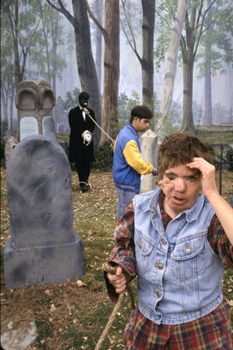
Shortly after this film was a press screening for “What Is It?,” the writing/directing debut of Mr. Crispin Glover, who is the craziest person I have ever met. The film confirms it. It’s not so much a movie as a cry for help. Most of the cast are people with Down syndrome, I kid you not. Glover himself plays a kingly underworld sort of guy who seems to be afraid that one of the Down syndrome guys thinks he (the Down syndrome guy) is Glover. I don’t know why Glover thinks the kid thinks that, but he does. The Down syndrome kid himself, meanwhile, is fond of tormenting snails. Also, there is a man in blackface who wants to be an invertebrate. Also, there is a scene where a naked woman with a monkey mask on brings a watermelon to a naked middle-aged retarded man who is reclining on a giant clam shell. All of this is joined together by absolutely no plot, at least not that I could discern. It is probably the strangest movie I ever seen. I kinda liked it.
This was only three movies for the day, but I was feeling very tired and there was nothing else showing in Park City that I felt like seeing. Just like last night, I decided to call it an early night. This time, I actually made it to my car and drove home to Salt Lake City.
As I got into town, though, it occurred to me that there are Sundance Film Festival venues IN Salt Lake City, where I live! I had never taken advantage of that fact before, because prior to this year, I lived 40 minutes away in Orem, so driving to The SLC wasn’t much better than driving to Park City. But now I live in The SLC, and in fact I live within walking distance of the Broadway Centre, where Sundance occupies as many as three screens during the festival. (Please do not take the term “walking distance” to mean that I actually walked there.)
It was 9:15, and I saw in the schedule (which I looked at while I was driving) that “The Chumscrubber” was to commence at 9:45. This film stars Jamie Bell, who I’ve always thought was a good young actor, and there have been no press screenings at all and only two public screenings in Park City. This would be my only chance to see it.
So once again, my plans to have an early night were thwarted when I accidentally watched a movie. But unlike last night, I’m glad it happened. “The Chumscrubber” is a very good movie set in sunny suburbia, and detailing the oddness of adults and the unsupervised mayhem of teenagers. It reminded me a bit of “Donnie Darko,” but in a good way: the surreal middle-class characters, the hallucinatory protagonist, the deeper themes of angst and death. It’s a comedy, more or less, but it’s also a satire and a mystery. I hope it gets picked up for release, because I would like to see it again.
Oh, and it has Ralph Fiennes in it, except the whole time I thought he was Liam Neeson. It wasn’t until I looked at the cast list that I realized it was Fiennes. Ditto Carrie-Anne Moss, who I thought was Sarah Clarke (Nina Myers from “24”). Maybe it didn’t even star Jamie Bell. Obviously my eyes aren’t to be trusted.
Day 9 (Friday, Jan. 28, 2005):
After a brief burst of icky weather yesterday, the skies were clear again today as I headed to Park City for my last full day of the festival. Sundance definitely winds down around this time. Many members of the press have headed home, most of the celebrities (except for those with films yet to premiere) are gone, and the crowds are smaller. The people who remain are noticeably tired and less chatty on the shuttle buses, like survivors of a holocaust.
I stopped by headquarters first to pick up the ticket I had requested for a public screening of “Murderball.” This documentary was the belle of the ball, buzz-wise, and was considered a “must-see.” There was to be a press screening tonight at 5, but that conflicted with the public screening of another must-see, “MirrorMask,” that I wanted to attend. So I’d requested this public-screening ticket of “Murderball.”
When I arrived at the table where Bert the helpful ticket guy works, he told me there was no need to attend the public screening at 11:15, because there was a press screening at 5. “Yes,” I said, “but that conflicts with the public screening of another must-see, ‘MirrorMask,’ that I wanted to attend.” He saw my dilemma and quickly issued me a “Murderball” ticket. Bert is the only guy I’ve ever known who was actually named “Bert,” but even if I knew many Berts, I’m sure he’d still be my favorite.
My friend Scott Renshaw of Salt Lake City Weekly has been taunting me all week for my dependency on the shuttle buses while he, being manly, often walks from Sundance headquarters to the Yarrow, a hike of about 10 minutes. I am not opposed to walking in general, but when it’s cold out, and there’s ice on the sidewalks, and the buses are warm and due to arrive, I’m sure, ANY time now — well, why walk? Besides, the buses are often the site of events which later make for amusing anecdotes. No amusing anecdotes ever happen when you’re walking, that’s for sure.
But it was now 10:50, and I believed “Murderball” to be starting at 11:15. The shuttle often takes 20 minutes to get to the Yarrow from headquarters due to the circuitous route it takes and due to many people believing the bus drivers to be their personal chauffeurs and insisting they stop at random intersections or in front of random condominiums. Not wanting to push my luck, I opted to walk instead, partly because it was faster and partly because I wanted Renshaw to respect me. On the way, a driver who was stopped at an intersection failed to look at the curb before turning right and therefore did not see me entering the crosswalk and therefore almost hit me. He missed me by mere inches, and I and thought, “Well, that would have been an amusing anecdote, for sure. And it would have gotten Renshaw off my back for never walking anywhere.” I sort of regretted not being struck by the car.
Turns out “Murderball” wasn’t scheduled to start until 11:30 and didn’t actually start until 11:45, but no matter. It’s a fantastic documentary, quite worthy of all the buzz that’s been circulating. It’s about the U.S. Paralympics Quadriplegic Rugby team, in which men with varying degrees of limitations upon their four limbs play rugby in souped-up, reinforced wheelchairs. “Murderball” is the colloquial name of the sport, and it’s apt. If you know how violent regular rugby can be, imagine it when steel and wheels have been added to the equation.
The sport itself is fascinating to watch, but even more compelling are the stories of the athletes. Some became paralyzed in extremely horrific ways — one was thrown from the bed of a pickup truck into a canal, where he clung to a branch for 14 hours before being discovered; another was tossed off a balcony during a fistfight — and all are candid about their injuries and their disabilities. The film even addresses the question on everyone’s mind when they meet someone in a wheelchair: Can you still have sex? (Answer: yes!) “Murderball” is among my two or three favorite films of the festival.
After this I stuck around for a press screening of “212,” a little comedy about post-college New Yorkers making connections and falling in love in the Big City. I lasted about 20 minutes before I realized the film had failed to engage me in any way, and I left. By the end of the festival, my patience for mediocre films runs thin, and it’s not very thick to begin with.
So I walked — walked, Renshaw! In your face! — back to the press office to write and whatnot. The atmosphere had become more relaxed in this usually hectic place, too. While I was there, some of the volunteers and employees began playing a guitar and singing a song about pirates. This struck me as a perfectly reasonable thing to do, given all the stress they’d been under all week.
In the press lounge I saw a man who was associated with the film “Marilyn Hotchkiss Ballroom Dancing and Charm School.” Film-related people have nametags like the rest of us, except instead of their actual names, it just says the name of their film. So instead of saying “Eric Snider,” your nametag would say “Murderball” or “212” or whatever. I guess the people’s names don’t matter; all anyone wants to know is what movie they’re with. This guy’s tag said “Marilyn Hotchkiss,” as the full title was too long to include. Under “Marilyn Hotchkiss,” he had written his own name, apparently having gotten tired of people thinking his name was Marilyn. I thought that was funny. (Did you? Please check yes or no.)
At 6:00 I attended the aforementioned public screening of “MirrorMask” at the Eccles Theatre. This was a much-ballyhooed film boasting jaw-dropping visual imagery and creativity, in a “Wizard of Oz”/”Alice in Wonderland”-type fantasy story about a young girl who has to stop the Dark Queen from taking over the world, or something. I enjoyed the visual aspect of the film immensely, but the story itself (written by noted author Neil Gaiman) is somewhat lacking. Still, I would recommend it, especially on the big screen.
I saw Paul Provenza, director of “The Aristocrats,” in the lobby and engaged him in conversation for a moment so I could compliment his film and wish him well with it. I said I looked forward to the DVD, to see the comedians who got cut out; he said there were about six of them. No huge names among them, but he did say that Jerry Seinfeld was willing to do the project and simply hadn’t been able to arrange his schedule. Considering Jerry’s act is generally very clean and profanity-free, it would have been interesting to hear him tell a dirty joke. Alas, it was not to be.
I had half-hoped to make it back to the Yarrow for a press screening of “On a Clear Day” at 8:00, but I didn’t get out of “MirrorMask” until 7:50, and even Scott Renshaw couldn’t walk it in 10 minutes, and I knew a bus was hopeless. So I went to Plan B, which was to eat dinner with my friend Chris and his friend Greg, whose name turns out to be Craig. Seeking to take full advantage of the star-studded Sundance atmosphere, we went to Pizza Hut.
There was one more movie in store for me: a 10:00 press screening of “New York Doll.” This film was talked about a lot this week, which is why another press screening of it was added for tonight. It’s about Arthur “Killer” Kane, bass player for the early-’70s pre-punk group New York Dolls, a band I’d never heard of but which apparently laid the groundwork for later bands like the Clash and the Sex Pistols. This means the New York Dolls were indirectly responsible for Green Day, too, so I don’t know how proud of themselves they should be.
Anyway, Arthur Kane was an alcoholic who had hit rock bottom when, in 1989, he joined the Mormon Church. He cleaned his life up completely and became a fairly ordinary Mormon middle-aged man, all the while wishing for a reunion with his old bandmates. The film shows them reuniting for a concert in London in 2004, and the entire experience is very sweet and inspiring. This is a wonderful film about a genuinely nice man who found God and changed his life because of it. It, too, becomes one of my festival favorites this year.
Day 10 (Saturday, Jan. 29, 2005):
Today Park City was almost like the ghost town it is for 51 weeks out of the year. Everyone connected with Sundance was finishing up last-minute business or in hiding somewhere, resting up for the big end-of-festival party tonight.
I saw two movies. Both were public screenings. Only one of the three press-screening venues was still in operation today, and it was only showing films I’d already seen. Over 120 press-screening slots over the course of the festival, and some movies get shown three times while others get none. It’s not fair, I tells you.
At noon I saw “Protocols of Zion,” a fascinating documentary by Jewish filmmaker Marc Levin in which he examines the current state of anti-Semitism in America. There has been an upswing since 9/11, with some conspiracy theorists saying the Jews were responsible for those attacks, pointing to the fact that no Jews were killed, and that 4,000 Jews who worked in the Twin Towers did not show up to work that day.
Of course, these “facts” are completely bogus — just look at the wall listing the names of the dead and you can pick out hundreds of Jewish names — but facts seldom get in the way of people hating each other. The film takes its title from a book published a century ago that purported to be the minutes from a meeting of Judaism’s top elders as they discussed their insidious plans for world domination. Problem is, the meeting never took place, and the book is a 100-percent fraud. Yet to this day, some people still believe its talk of the Jews wanting to take over the world and exterminate all gentiles.
The documentary was interesting to me because, not being Jewish and not living in an area where many people are Jewish, I do not witness anti-Semitism on a regular basis. I wasn’t aware of its prevalence. How many other people are hating each other without me knowing it?
Speaking of hating, I next saw “Dirty Love,” a despicable and unfunny film starring former celebrity Jenny McCarthy, who also wrote the screenplay. It resembles “Sex and the City,” except it is set in Los Angeles and is not the least bit funny. McCarthy apparently believes that if she makes goofy faces all the time, that is the same thing as being funny. In fact, I wanted nothing more than to smack her, savagely and repeatedly, until she quit making those effing faces.
It was a terrible film to end the festival with, but it does allow me to quote the greatest example of hyperbole in this year’s Sundance film guide. John Cooper writes, “‘Dirty Love’ could well establish (McCarthy) as the Lucille Ball of the new millennium.” I’m not even a huge Lucille Ball fan, but I think this statement offends me.
It was only 5 p.m. when “Dirty Love” was over, but I had some non-festival obligations to attend to. And so the festival is over for me now. There are more screenings tomorrow, but mostly of the films that won awards (most of which I’ve seen). Besides, TiVo has a lot of things waiting for me that I simply must catch up on.
Ah yes, the awards. There is a jury who sees all the films in the competition categories and chooses winners, and then there are winners chosen by audience voting, too. Think of the Academy Awards vs. the People’s Choice Awards. In the American documentary category, the jury chose the somber “Why We Fight” (no surprise; it’s a Very Important film), while the audience selected the superior “Murderball.” In the world documentary contest, the jury went with “Shape of the Moon,” and the audience chose “Shake Hands with the Devil: The Journey of Romeo Dallaire.” So far, I am two-for-two in agreeing with the audience rather than the jury.
In the American dramatic competition (“dramatic” simply meaning non-documentary, not necessarily that the films are dramas), the jury prize went to “Forty Shades of Blue,” which astounds me, because I wasn’t aware of anyone really liking that film all that much. The audience, on the other hand, chose “Hustle & Flow,” perhaps because Paramount bought it for $9 million and everyone therefore assumed it must be really good.
In the area of foreign films, the jury chose “The Hero,” while the audience voted for “Brothers.” I didn’t see either film, but I suspect I would like “Brothers” more, given that so far I have not been thrilled with the jury’s choices.
There were a few “Special Jury Prizes” for some films, but since I don’t really understand the criteria — if you liked the film so much, why didn’t it win the REAL prize instead of some “special” prize? — I’m not going to get into it.
This was my sixth year covering the festival, but the first time that it has ended without me being ready for it to. Usually by now I’m burnt-out and somewhat relieved that it’s over. But this year is different. Today I wanted to cancel my other obligations and see something else after “Dirty Love.” I wanted to cancel the things I’m supposed to do tomorrow and catch whatever remaining screenings there are. I want the festival to go on for another week, so I can see “The Squid and the Whale” (I never did make those 9 a.m. screenings…) and “Grizzly Man” and “The Devil and Daniel Johnston” and “Twist of Faith” and all the others that I heard good things about that I was unable to see.
Kudos are in order to Geoffrey Gilmore and the others who program the festival, their pro-“Dirty Love” exaggeration notwithstanding. The festival continues to grow and improve, and it is largely due to their selection of diverse, interesting films. My thanks also to Patrick Hubley, Sundance’s head of media relations who oversees everything pertaining to the hundreds of members of the press who attend the festival, and who does so with grace and good humor; and to Sarah George in the materials office for handling all the press kits and screener tapes and whatnot; and to Bert Hall, who has the awesome responsibility of granting or not granting public-screening tickets to members of the press who request them, and who only denied one of my requests this year.
The shuttle buses were screwy, and the documentaries far exceeded the narrative films in terms of quality, and Paris Hilton was permitted to enter the boundaries of Park City … but still, Sundance 2005 was a fantastic, enriching experience for me. I feel like the woman I talked to who is from Colorado and who decided on a whim to attend the festival, who was having such a great time that she said, “Now I can’t imagine not coming back every year.” I can’t imagine it, either.

